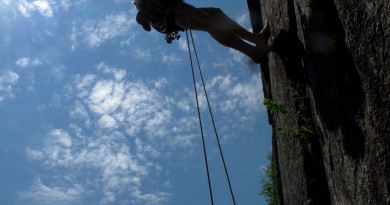Watch out for rock climbing injuries
By Nathan Endres, MD
Rock climbing has become increasingly popular as both a recreational activity and a competitive sport. Rock climbing is a general term that includes multiple forms of climbing- indoor climbing, sport climbing, bouldering, etc. There have been a number of studies performed, which describe rock climbing injuries, but these studies are hard to compare because they include different forms of climbing, different groups of climbers (experts vs. recreational climbers) and different types of injuries (only traumatic injuries presenting to an emergency department vs. all types of injuries). Despite these differences, some interesting information and general trends can be found that will hopefully be helpful to the climbing community here in Vermont.
– Rock climbing injuries are common. Somewhere between fifty and eighty percent of rock climbers report a climbing related injury annually.
– Overuse injuries are more common than acute injuries and most commonly affect the upper extremity, especially the hand and wrist. This is really no surprise as great forces are transmitted through the hands when they are repetitively used for the various climbing holds. Many injuries are associated with climbing maneuvers that place much if not all of the body weight on one or two fingers. Hand injuries can be very problematic as even minor injuries can compromise use of the hand as a climbing tool and reduce overall ability and even security.
– Elite climbers are most susceptible to overuse injuries of the fingers, whereas recreational climbers have a wider range of injuries, including more lower extremity injuries. This is related to increased technical difficulty and increased frequency of climbing. As with most overuse injuries, many overuse climbing injuries can be treated effectively with rest, training modifications, a course of anti-inflammatory medication and a directed therapy program (there are therapists who specialize in hand therapy). The therapy program may include a period of splinting or bracing.
– Common hand injuries include soft tissue injuries to the fingertips (abrasions and lacerations), tendon injuries, ligament sprains and carpal tunnel syndrome. A specific injury described in climbers is an injury to the A2 pulley of the flexor sheath. Each finger has a pulley system that keeps the flexor tendons (the tendons that help make a grip) from bowstringing and losing mechanical advantage. A pulley rupture typically involves a history of an audible pop and swelling during sudden forced extension of the finger. This most commonly involves the long and ring fingers. This may lead to clear bowstringing of the tendon compared to the other hand. If you notice this problem, it is best evaluated by a hand specialist fairly quickly after the injury. Surgery may be recommended.
– Injuries of the shoulders are also common in rock climbers. The most frequently reported shoulder conditions are rotator cuff strains from overuse and dislocations from falls. Expert climbers have been shown to have increased thoracic kyphosis (forward bending of the middle of the spine in your back) and lumbar lordosis (backwards bending of the lower spine in your back) This adaptation is known as “climber’s back” and is often accompanied by shortened pectoralis muscles These postural adaptations have been linked to shoulder problems. Postural therapy, pectoralis stretching, and strengthening the rotator cuff muscles and muscles around the shoulder blade (trapezius, latissimus, rhomboids, serratus) can help overcome many overuse shoulder problems.
– Lower extremity injuries are not uncommon. Most involve the foot or ankle and are acute, traumatic injuries related to falls. Ankle sprains and foot fractures are the most common lower extremity injuries.
– Concussions and severe head injuries are rare. I did not find specific data on the use of helmets amongst rock climbers and their protective effect. However, injuries to the head in climbers were most often lacerations and resulted from being hit by an object. There is data from other sports like alpine skiing, which shows that helmets are effective at preventing head and face lacerations.
– Falls of greater than 20 feet were 10 times more likely to result in hospitalization than were falls of less than or equal to 20 feet.
– Rock climbers who participated in traditional or solo climbing or who have climbed while under the influence of drugs or alcohol reported more injuries.
**********
References:
Backe S EL , Janson S , Timpka T. Rock climbing injury rates and associated risk factors in a general climbing population. Scand J Med Sci Sports 2009; 19: 850 – 856
Förster R, Penka G, Bosl T, Schöffl VR. Climber’s back—form and mobility of the thoracolumbar spine leading to postural adaptations in male high ability rock climbers. Int
J Sports Med. 2009;30:53–59.
Gerdes EM, Hafner JW, Aldag JC. Injury patterns and safety practices of
rock climbers. J Trauma 2006: 61(6):1517–1525.
Jones G, Asghar A, Llewellyn DJ. The Epidemiology of Rock Climbing Injuries. Br J Sports Med 2008;42:773–778.
Kubiak EN, Klugman JA, Bosco JA. Hand Injuries in rock Climbers. Bulletin of the NYU Hospital for Joint Diseases • Volume 64, Numbers 3 & 4, 2006
Nelson NG , McKenzie LB . Rock climbing injuries treated in emergency departments in the U.S., 1990 – 2007 . Am J Prev Med 2009; 37 : 195 – 200.
Neuhof A et al. Injury Risk Evaluation in Sport Climbing. Int J Sports Med 2011; 32: 794 – 800.
Rohrbough JT, Mudge MK, Schilling RC. Overuse injuries in the elite rock climber. Med Sci Sports Exerc 2000:32(8): 1369–1372.
**********
Nathan Endres, MD is an orthopaedic surgeon and assistant professor at the University of Vermont. He is fellowship trained in sports medicine, shoulder surgery and orthopaedic trauma. He is a member of the United States Ski and Snowboard (USSA) physician pool.


